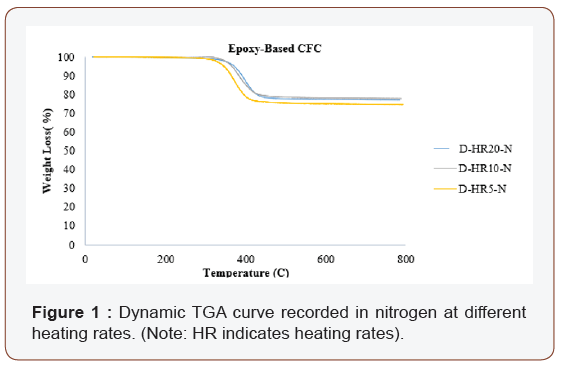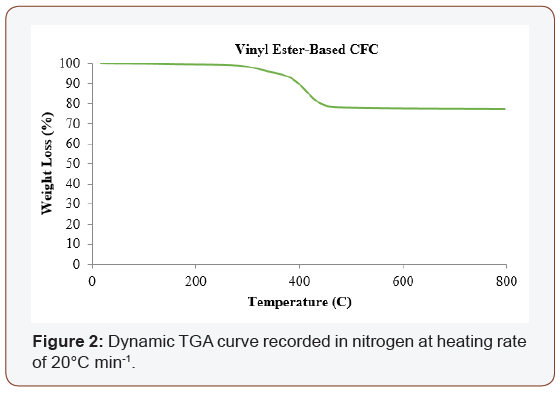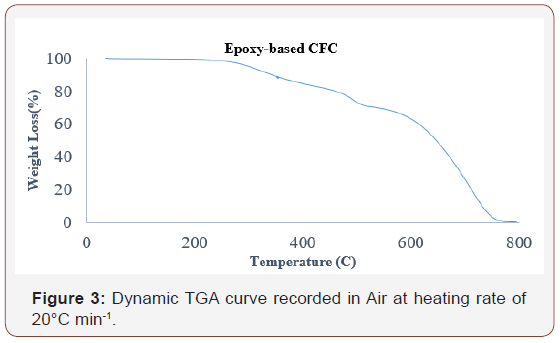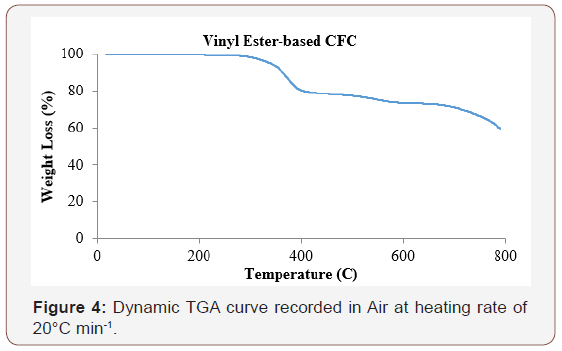 Mini Review
Mini Review
Dynamic Thermogravimetric Analysis of Recycled Carbon Fiber Composites: Mini Review
Seyed Hossein Mamanpush1,2*, Reyhaneh Tavousi Tabatabaei2 and Bahareh Tavousi Tabatabaei2
1Composite Materials and Engineering Center, Washington State University, Pullman, WA, 99163, USA
2Department of Engineering, Islamic Azad University, Khomeyni Shahr Branch, Isfahan, Iran
Seyed Hossein Mamanpush, Composite Materials and Engineering Center, Pullman, WA, 99163, USA.
Received Date: November 06, 2018; Published Date: November 15, 2018
Abstract
Thermogravimetric analysis (TGA) is one of the most popular analysis techniques to study the decomposition process of polymeric materials in controlled atmospheres at various temperatures. In this review, dynamic TGA was carried out to determine the thermal stability of the recycled epoxy-based and vinyl ester-based carbon fiber composite (CFC). The specimens were heated from ambient to 800°C under nitrogen and air at different heating rates. Results indicates that different heating rates has no significant influence on the degradation of the epoxy-based CFC.
Keywords: Recycling; TGA; Carbon fiber composite
Introduction
TGA can be used to evaluate the thermal stability of a material. In a desired temperature range [1,2], if a species is thermally stable, there will be no observed mass change [3]. Negligible mass loss corresponds to little or no slope in the TGA trace [4,5]. The dynamic TGA results of recycled epoxy-based CFC materials at different heating rates indicate that there is no significant difference among the thermal degradation profiles (Figures 1 & 2). For the heating rate of 5°C m-1 degradation events started around 300°C and at the heating of 10°C m-1 and 20°C m-1 it started around 330°C [6,7]. At 800°C the TGA results of recycled epoxy-based CFC material shows the residue around 75% that remained, this can be assigned to the carbon fiber content of the sample [8-10].


Based on this fact that heating rate has no significant influence on the TGA results of recycled CFCs [11], for recycled vinyl esterbased CFCs we just consider the 20°C min-1 heating rete (Figures 3 & 4). For vinyl ester-based CFC material degradation event occur between 300°C to 456°C. At 800°C the TGA results of recycled vinyl ester-based CFC material shows the residue around 77% that remained, this can be assigned to the carbon fiber content of the sample [12]. Comparing the TGA results of recycled epoxy-based CFC and vinyl ester-based CFC shows that there is no significant difference between degradation behavior of them. The TGA results of recycled CFCs in air show that recycled vinyl ester-based CFC have better thermal stability comparing to epoxy-based CFCs. At 800°C the TGA results of recycled vinyl ester-based CFC material shows the residue around 59% that remained, and results of recycled epoxy-based CFC material shows the residue around 0%, it shows the significant thermal stability of vinyl ester-based CFC in air.


Conclusion
Recycled CFCs are a viable material for making second generation composites. The obtained results from dynamic TGA of recycled carbon fiber composite materials demonstrate that recycled CFCs have superior thermal stability. Results indicates that different heating rates has no significant influence on the degradation of the epoxy-based CFC.
Acknowledgement
None.
Conflict of Interests
No Conflict of Interest.
References
- Hui Li, Karl Englund (2016) Recycling of carbon fiber-reinforced thermoplastic composite wastes from the aerospace industry. Journal of Composite Materials 51(9): 1265-1273.
- Mamanpush H, Golestanian H (2014) Investigating the effects of carbon nanotube orientation on the macroscopic stiffness of nanocomposites. Int J Curr Life Sci 4(4): 1168-1174.
- Mamanpush H, Golestanian H (2014) Evaluation of effective material properties of randomly distributed carbon nanotube composites considering interface effect. Indian J Sci Res 2(1): 132-142.
- Thostenson ET, Karandikar PG, Chou TW (2005) Fabrication and characterization of reaction bonded silicon carbide/carbon nanotube composites. J Phys D Appl Phys 38(21): 3962-3965.
- Song YS, Youn JR (2006) Modeling of effective elastic properties for polymer-based carbon nanotube composites. Polymer 47(5): 1741- 1748.
- Mamanpush H, Golestanian H (2014) Effects of carbon nanotube dispersion on the mechanical properties of nanocomposites considering interface effect. International Journal of Current Research 4(8): 4366- 4373.
- Seyed Hossein Mamanpush, Hui Li, Karl Englund, Azadeh Tavousi Tabatabaei (2018) Recycled wind turbine blades as a feedstock for second generation composites. Waste Management 76: 708-714.
- Seyed Hossein Mamanpush, Azadeh Tavousi Tabatabaei, Hui Li, Karl Englund (2018) Data on the mechanical properties of recycled wind turbine blade composites. Data in Brief 19: 230-235.
- Seyed Hossein Mamanpush, Hui Li, Karl Englund, Azadeh Tavousi Tabatabaei (2018) Dataset demonstrating physical properties of recycled wind turbine blade composites. Data in Brief 20: 658-661.
- Seyed Hossein Mamanpush, Azadeh Tavousi Tabatabaei (2018) Innovative Method in Recycling Wind Turbine Blades: Mini Review. Evolutions Mech Eng 1(1): 1-2.
- Seyed HM, Zohre MG, Hossein G (2018) Numerical Modeling of Nano Bundle and Nano Rope-Reinforced Polymer Mechanical Properties. Evolutions Mech Eng 1(4): 1-9.
- Azadeh Tavousi Tabatabaei, Seyed Hossein Mamanpush, Bahareh Tavousi Tabatabaei (2018) Effects of Carbon Nanotube Dispersion on the Material Properties of Polymer Matrix Composites. Evolutions Mech Eng 1(3).
-
Seyed Hossein Mamanpush, Reyhaneh Tavousi Tabatabaei, Bahareh Tavousi Tabatabaei. Dynamic Thermogravimetric Analysis of Recycled Carbon Fiber Composites: Mini Review. Glob J Eng Sci. 1(2): 2018. GJES.MS.ID.000508.
-
Perspective sketching, Perspective drawing method, Perspective drawing techniques, Perspective sketching, Perspective drawing method, Perspective drawing techniques, Proximity Method, Building Plan (Footprint) Method, Perspicere, Foreshortening, Vertical perspective, Sceneries, Arial level, Datum line, Davinci notes, Zeeman's paradox, AutoCAD, Scale magnification method, Zeeman
-

This work is licensed under a Creative Commons Attribution-NonCommercial 4.0 International License.






